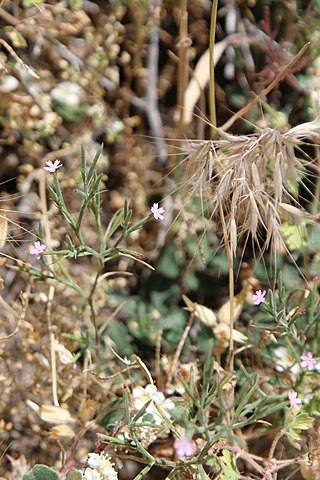
Caryophyllaceae, commonly called the pink family or carnation family, is a family of flowering plants. It is included in the dicotyledon order Caryophyllales in the APG III system, alongside 33 other families, including Amaranthaceae, Cactaceae, and Polygonaceae. It is a large family, with 81 genera and about 2,625 known species.

The curry tree or Bergera koenigii, is a tropical and sub-tropical tree in the family Rutaceae, native to Asia. The plant is also sometimes called sweet neem, though M. koenigii is in a different family to neem, Azadirachta indica, which is in the related family Meliaceae.

Gypsophila is a genus of flowering plants in the carnation family, Caryophyllaceae. They are native to Eurasia, Africa, Australia, and the Pacific Islands. Turkey has a particularly high diversity of Gypsophila taxa, with about 35 endemic species. Some Gypsophila are introduced species in other regions.

Rhynchospora is a genus of about 400 species of sedges with a cosmopolitan distribution. The genus includes both annual and perennial species, mostly with erect 3-sided stems and 3-ranked leaves. The achenes bear a beak-like tubercule and are sometimes subtended by bristles. Many of the species are similar in vegetative appearance, and mature fruits are needed to make a positive identification.

Minuartia is a genus of flowering plants commonly known as sandworts in the family Caryophyllaceae.

Aurantioideae is the subfamily within the rue and citrus family (Rutaceae) that contains the citrus. The subfamily's center of diversity is in the monsoon region of eastern Australasia, extending west through South Asia into Africa, and eastwards into Polynesia.

Dianthus nudiflorus, synonym Velezia rigida, is a species of flowering plant in the family Caryophyllaceae. It is native to the Mediterranean Basin countries of Europe and North Africa, and to western and central Asia and Pakistan. It is also present in northern California where it is an introduced species. It is an annual herb growing from a taproot and producing a hairy, glandular, branching green or purplish stem up to 40 centimeters tall. The linear leaves are up to 2 centimeters long. Solitary flowers occur in the leaf axils. Each flower has a very long, cylindrical, ribbed calyx of fused sepals forming the tubular throat of the flower, measuring at least a centimeter in length. At the top of the tube is the flower corolla which has five pink or purplish petals.

Geocarpon cumberlandense is a rare species of flowering plant in the pink family known by the common names Cumberland stitchwort and Cumberland sandwort. It is endemic to the Cumberland Plateau near the Big South Fork of the Cumberland River in Tennessee and Kentucky. This rare plant is found only in cool sandstone rock shelters, on the moist sandy cave floors behind the drip line. There are 27 occurrences in Tennessee and one in Kentucky. The plant is a federally listed endangered species.
Xerotia arabica is a species of flowering plant belonging to the family Caryophyllaceae. It is the sole species in genus Xerotia. It is a subshrub or shrub native native to Yemen and Oman in the southern Arabian Peninsula, where it grows in deserts and dry shrublands.
Triplateia moehringioides is a species of flowering plant in the carnation family, Caryophyllaceae. It is the sole species in genus Triplateia. It is an annual or subshrub native to northern, central, and southwestern Mexico, where it grows in deserts and dry shrublands.
Polytepalum angolense is a species of flowering plant belonging to the family Caryophyllaceae. It is endemic to Angola. It is the sole species in genus Polytepalum.
Kabulia is a genus of flowering plants belonging to the family Caryophyllaceae.
Mcneillia is a genus of flowering plants belonging to the family Caryophyllaceae.

Mononeuria is a genus of flowering plants belonging to the family Caryophyllaceae.
Reicheella is a genus of flowering plants belonging to the family Caryophyllaceae. It has a synonym of BryopsisReiche, and only contains one known species, Reicheella andicola(Phil.) Pax
Rhodalsine geniculata is a species of flowering plant belonging to the family Caryophyllaceae. It is the sole species in genus Rhodalsine.
Selleola is a monotypic genus of flowering plants belonging to the family Caryophyllaceae. The only species is Selleola ekmaniana.
Pteranthus is a monotypic genus of flowering plants belonging to the family Caryophyllaceae. The only species is Pteranthus dichotomus.
Pentastemonodiscus is a monotypic genus of flowering plants belonging to the family Caryophyllaceae. The only species is Pentastemonodiscus monochlamydeus.

Bergera is a genus of flowering plants in the family Rutaceae. It has been included in Murraya as M. sect. Bergera. Species that may be placed in the genus are native from India through southeast Asia eastwards to China and Taiwan southwards to Malesia and New Caledonia. The curry tree, Bergera koenigii, is one of the better known species.









